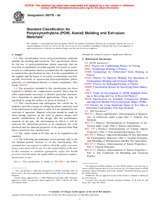We need your consent to use the individual data so that you can see information about your interests, among other things. Click "OK" to give your consent.
ASTM D6778-06
Standard Classification for Polyoxymethylene (POM, Acetal) Molding and Extrusion Materials
STANDARD published on 1.11.2006
The information about the standard:
Designation standards: ASTM D6778-06
Note: WITHDRAWN
Publication date standards: 1.11.2006
SKU: NS-36489
The number of pages: 6
Approximate weight : 18 g (0.04 lbs)
Country: American technical standard
Category: Technical standards ASTM
Annotation of standard text ASTM D6778-06 :
Keywords:
acetal, acetal copolymer, acetal homopolymer, acetal terpolymer, classification, classification system, line callout, L-P-392A, MIL-P-46137A (MR), plastic materials, polyformaldehyde, polyoxymethylene, polyoxymethylene copolymer, polyoxymethylene homopolymer, polyoxymethylene terpolymer, POM, ICS Number Code 83.140.01 (Rubber and plastic products in general)
Additional information
| 1. Scope | ||||||||||||||||||||||||||||||||||||||||||||
|
1.1 This classification covers polyoxymethylene materials suitable for molding and extrusion. This specification allows for the use of polyoxymethylene plastic materials that are recycled, reconstituted, recycled-regrind, recovered, or reprocessed, or combination thereof, provided that the requirements as stated in this specification are met. It is the responsibility of the supplier and the buyer of recycled, reconstituted, recycled-regrind, recovered, or reprocessed polyoxymethylene plastic materials, or combination thereof, to ensure compliance. (See Guide D 5033). 1.2 The properties included in this classification are those required to identify the compositions covered. There may be other requirements necessary to identify particular characteristics important to specialized applications. These may be specified by using the suffixes as given in Section . 1.3 This classification and subsequent line callout are intended to provide a means of calling out plastic materials used in the fabrication of end items or parts. It is not intended for the selection of materials. Material selection should be made by those having expertise in the field of plastics design after careful consideration of the design and the performance required of the part, the environment to which it will be exposed, the fabrication process to be employed, the costs involved, and the inherent properties of the material other than those covered by this classification. 1.4 The values stated in SI units are to be regarded as the standard. The following precautionary caveat pertains only to the test method portion, Section , of this classification. This standard does not purport to address all of the safety concerns, if any, associated with its use. It is the responsibility of the user of this standard to establish appropriate safety and health practices and determine the applicability of regulatory requirements prior to use. Note 1This classification is similar to ISO 9988-1 and 9988-2, although the technical content is significantly different. |
||||||||||||||||||||||||||||||||||||||||||||
| 2. Referenced Documents | ||||||||||||||||||||||||||||||||||||||||||||
|
We recommend:
Technical standards updating
Do you want to make sure you use only the valid technical standards?
We can offer you a solution which will provide you a monthly overview concerning the updating of standards which you use.
Would you like to know more? Look at this page.




 Cookies
Cookies
